May 12th, 2014 §
Last week most of my car trips included a chirping cardboard box riding shotgun. I delivered the chicks, which hatched in March, to their new owners. The little black pullet went to an acquaintance, a Wheaten Ameraucana pullet found a new and loving home with one of my Master Gardener friends, and the four Wheaten Ameraucana cockerels sold on CraigsList within an hour. Isn’t he handsome?
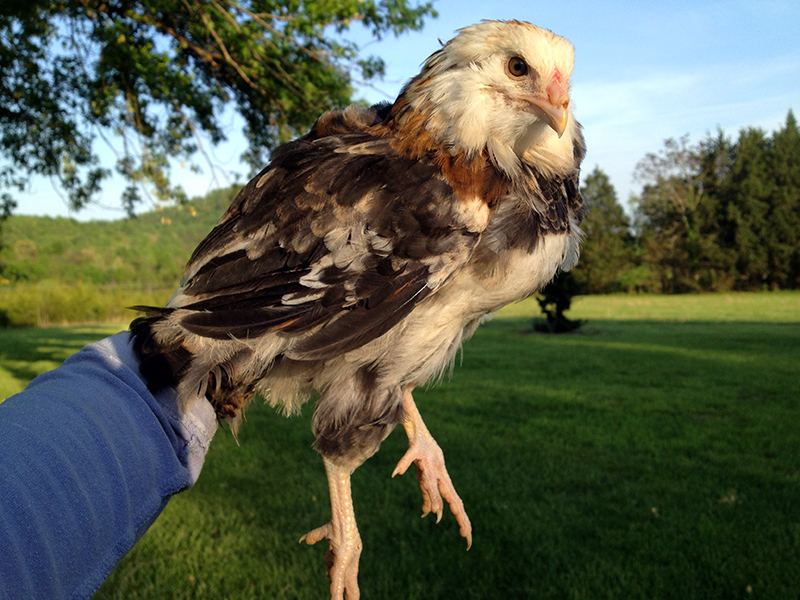
I kept two pullets. One is a pure Wheaten Ameraucana (in front below) and the other is a mystery hatched from a green egg out of a black mother! I love chickens at this age—about ten weeks—because they are sweet and curious, fully feathered but still small enough to pick up with one hand. They’re like little mini chicken pocket pets.
During the day I take the pullets out of their broody coop in the garage and put them in Tucker’s old puppy crate on the grass, and they eat their fill of clover, chickweed, whatever unfortunate bug comes along, and any grubs I unearth while digging in the garden. Last night they got to try pear for the first time.
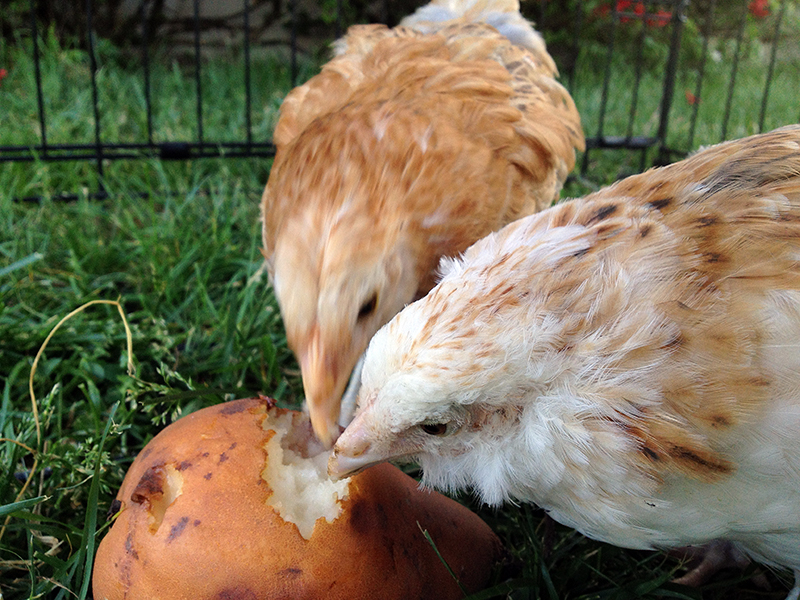
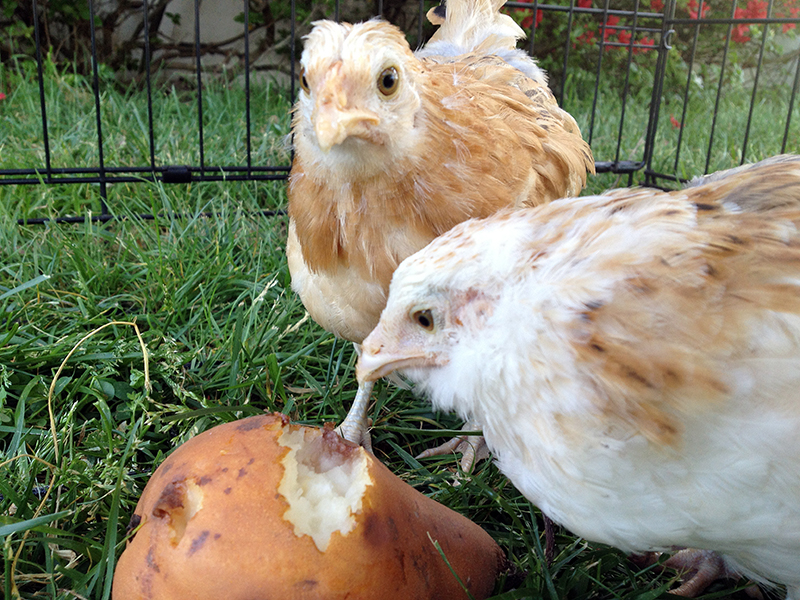
I am a bit sad that chick season is drawing to a close. If I could, I’d raise chickens all year long. I don’t think I will ever get tired of watching eggs turn into bright-eyed, beautiful birds.
Speaking of which, Mr. and Mrs. Bluebird are busy with their brood of four in the bluebird box. It’s wonderful to be back in bluebird season.
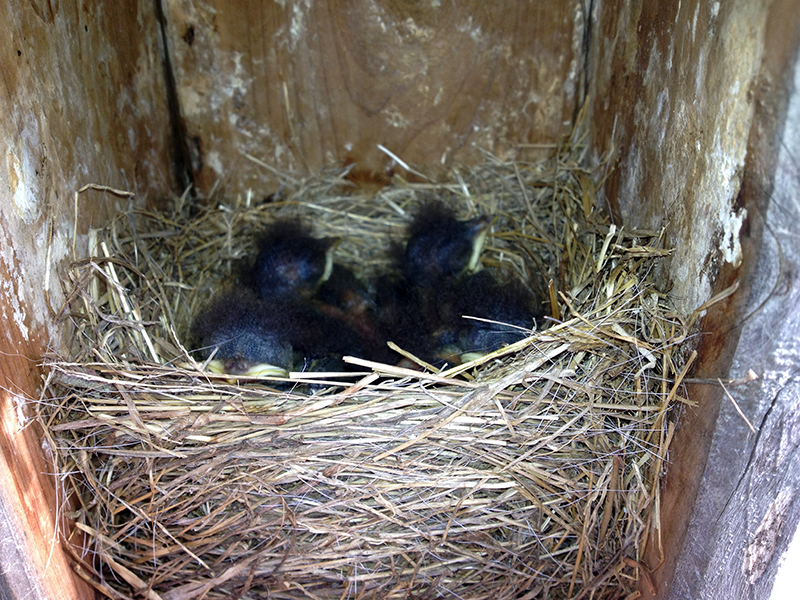
And finally, on a less joyful note, the feisty broody hen that hatched this latest batch of chicks wasn’t feisty enough when I returned her to the main flock. Despite holding her own for two days, on the eve of her third day back I found her with a quarter-size hole torn in the back of her skull. In her pain and panic to get away from her attackers she actually jumped into my arms from the nesting box. It’s the exact same wound Oregano sustained under similar circumstances, though this hen’s is worse.
She’s been getting daily Bactine spray and Neosporin plus Blue-Kote spray (which dyes her wound purple). I wish that I would have stitched her wound when I found it. She keeps knocking it open and it’s taking a very long time to heal, having to close from the outside in across basically her entire skull. In fact it’s larger now than it is in this photo, which I took a couple of weeks ago.
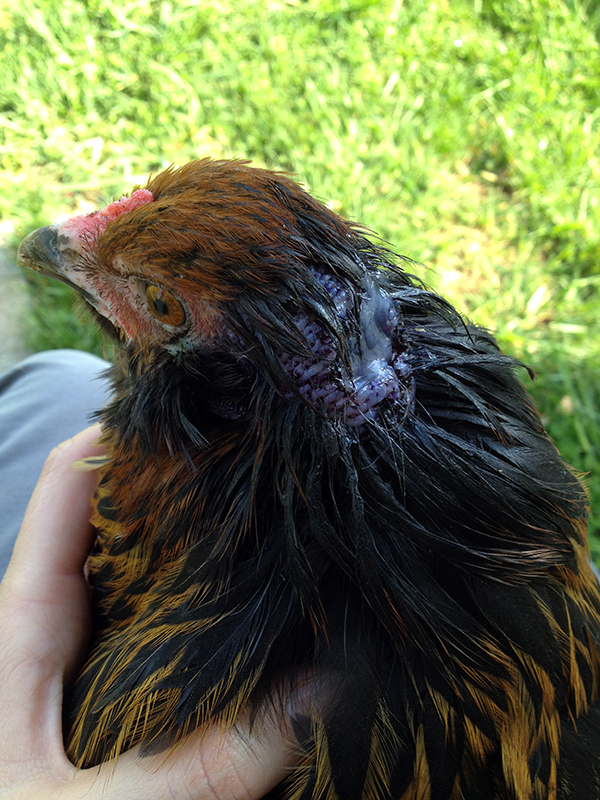
She doesn’t act hurt and has returned to laying eggs. As long as her wound doesn’t get infected I will just keep what I am doing and let it heal itself. My experience with Cora taught me that chickens can recover from the most dramatic wounds. This little hen is protected within another dog crate within the main coop, and will be until she heals and can successfully reintegrate with the flock.
This is what she gets for successfully raising the offspring of her sister flock mates. The injustice!
March 1st, 2014 §
Last night I drank half a glass of wine and candled the 15 eggs I’d put under a newly broody hen Sunday. What, this isn’t your idea of a rocking Friday night?
Maybe not for most people, but for me candling eggs induces Christmas-morning excitement. There are few things cooler in this world than getting to peek into an intact egg, with nothing more than a flashlight, and see bright red veins, a beating blob of heart and small dark eye. It is a magic trick, a miracle, and all those other things that make me grateful to be along for this wild ride.
Out of fifteen eggs, eight were definitely on the road to becoming chicks. One egg was a big fat question mark, and I magnanimously returned it to the clutch. I suspected five eggs were infertile, and in the interest of self education I risked destroying embryos to crack the eggs into a white bowl to check. All five were totally clear. My instinct and eye must be getting sharper.
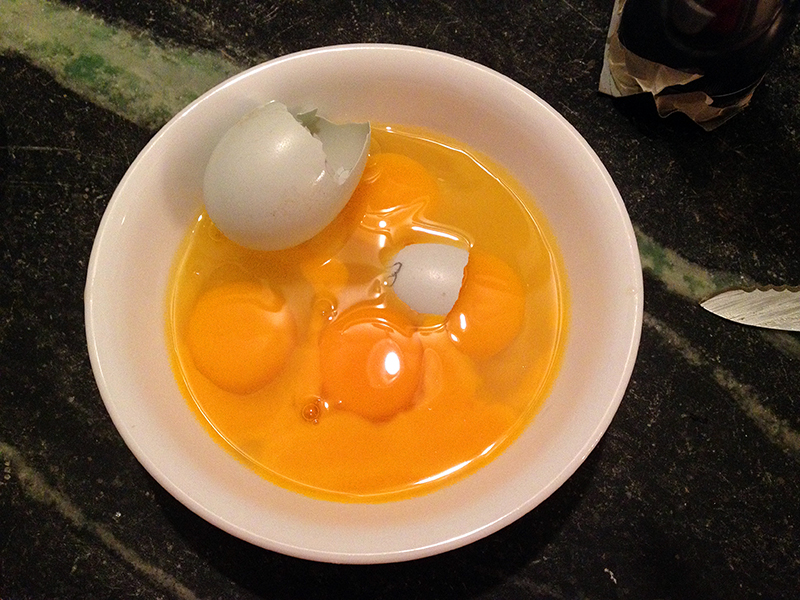
I didn’t take any photos of the developing eggs this time because I wanted them to be out in the cold air as little as possible. In fact, I withdrew them from under their mother two at a time, quickly candled them, and then snuggled them into a pan full of clean towels to hold their heat as much as possible. The whole operation was over in minutes. My pipes may have fallen victim to the polar vortex, but my potential chicks shouldn’t. If you want to see candling photos, they’re here.
I have high hopes for this hen as a broody. She’s one of last summer’s olive egger babies, and there’s a 50% chance she is Dahlia’s daughter. I only mention that because broodiness is a genetic trait. The young broody started plucking her breast feathers out a few weeks ago, and then hunkered down on all her flockmates’ eggs, hissing violently at any chicken that got too close. She’s the only broody out of the four I’ve had that’s actually pecked at me when I reached under her, and I take this feistiness as a good sign. I suppose I should name her as she’s definitely distinguishing herself.
I was on the fence about whether to do chicks again, but finally decided that it’s the best part of chicken keeping and costs me nothing. So I moved the broody to a coop in the garage, where she settled immediately despite being moved during the day, having a raucous rooster (Griz) in the coop next door, and me driving the loud and stinky tractor in and out right after the move. She remained steadfast, I set the eggs, and here we are.
I placed four eggs from my Coronation Sussex, two from last year’s olive egger babies, and nine Wheaten Ameraucana eggs from Cora under the hen. I removed all four of the Coronation eggs tonight, which were all infertile, and one Wheaten Ameraucana egg that was one of the oldest I placed, and had also cycled through the refrigerator as I waffled. I find it telling that my Coronation Sussex hen is the only bird that still has luxuriant feathers on her back and all her eggs were infertile. The hens that laid the fertile eggs are all looking a bit sparse back there because of Calabrese’s attentions. Another lesson learned—keep an eye out for “favorite” hens when scouting future mothers.
I just read back through last summer’s pained posts on hatching eggs, and I have to say that after that experience and this, I will never again let a hen set eggs in the middle of the summer. I realize now that the heat was really detrimental, leading to spoiled eggs that burst and contaminated the nest, and to chicks that were born prematurely and deformed. Incubating in the winter is the way to go. Live and learn.
But then again, we’re only five days into the 21-day incubation period, so let’s not count our chicks before they hatch, right?
July 24th, 2013 §
The chicks are growing by the hour, and their new trick is to jump on Dahlia’s back and ride around a bit before sliding/flying off. She is amazingly patient with these constant assaults, which are probably way more cute to me than they are to her.
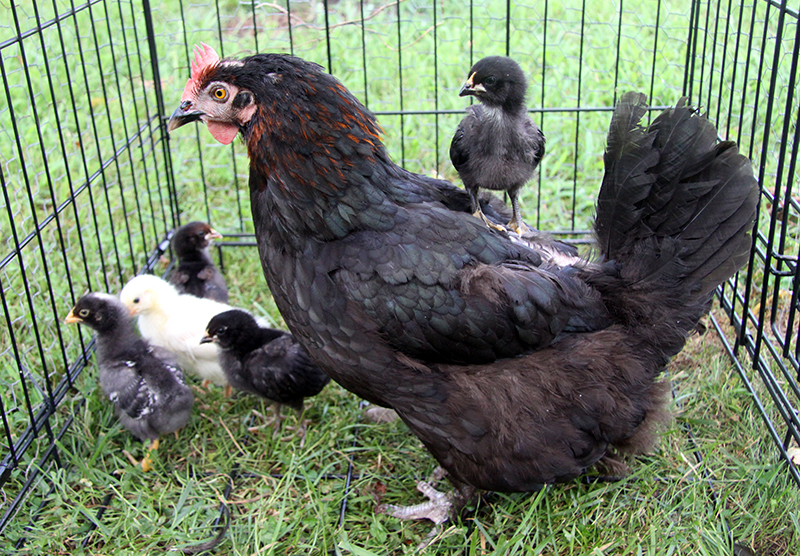
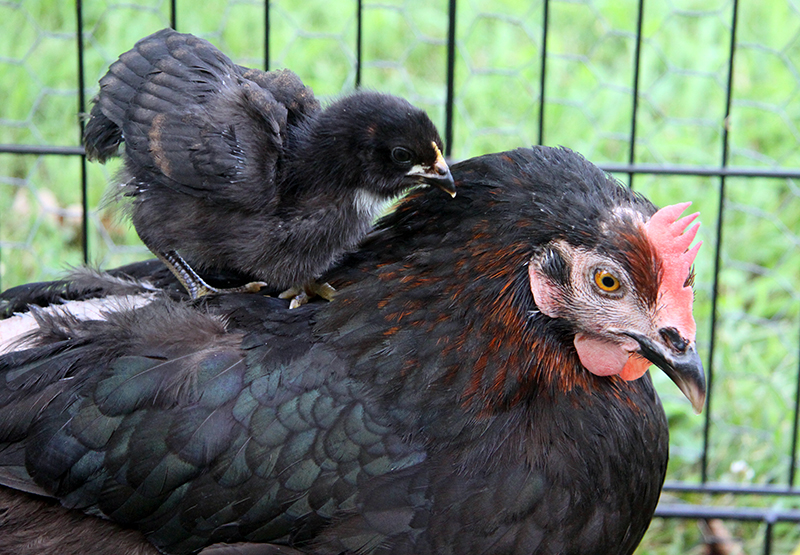

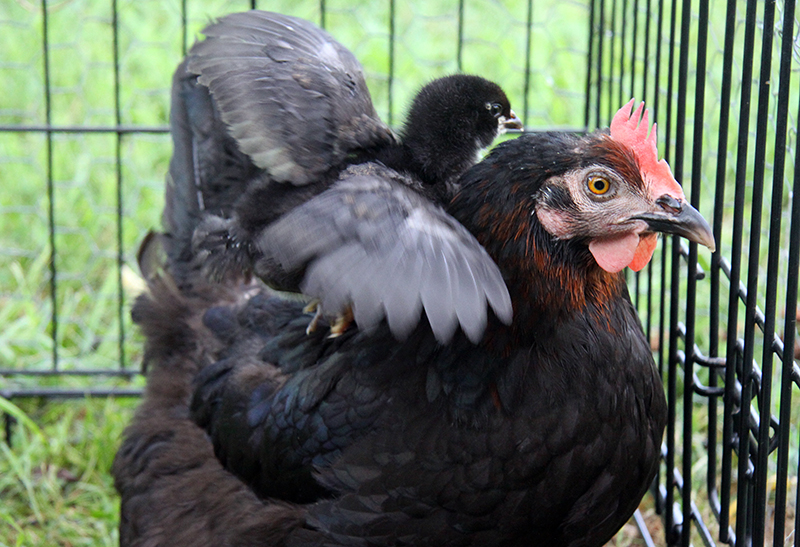
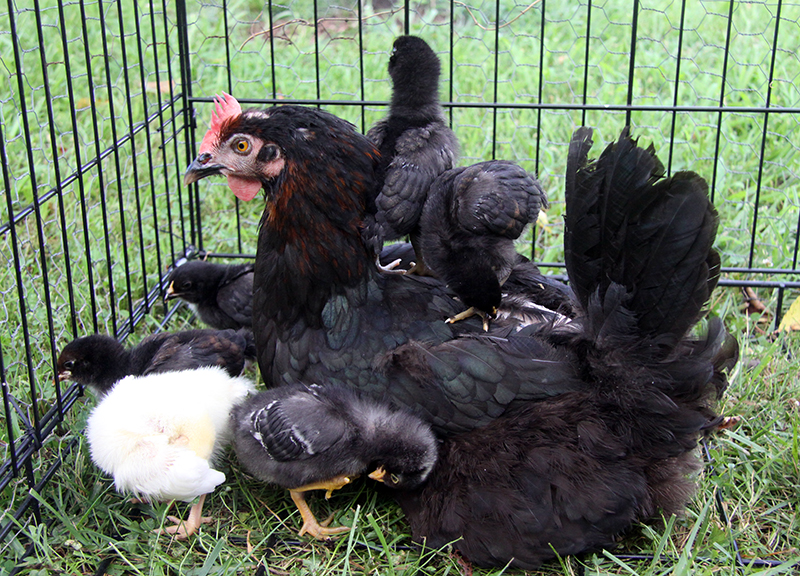
All this action shows me the chicks are ready for new adventures. On Saturday night I wrapped Tuckers’ puppy crate in chicken wire to make an escape-proof pen, and took the chicks outside for their first real exposure to grass and dirt. I’ve had then out every evening for a bit, and it’s neat to watch them learn how to scratch, hunt bugs, and eat clover. It’s amazing how much the chicks change and grow from day to day. Just two weeks old and they’re well on their way to being big chickens.
July 16th, 2013 §
Enough of bloody flock power struggles. Let’s talk about the happy family living in the broody coop in the garage. Dahlia is a very calm and patient mother, and protective. She flew out of the coop last night when I took one of her chicks out to hold and she heard its distress cries. She’s doing a great job with her six chicks. They’re growing and changing by the day, and are already feathering out. It’s exciting to see a lot of copper brown in the new feathers of the black olive-egger chicks.
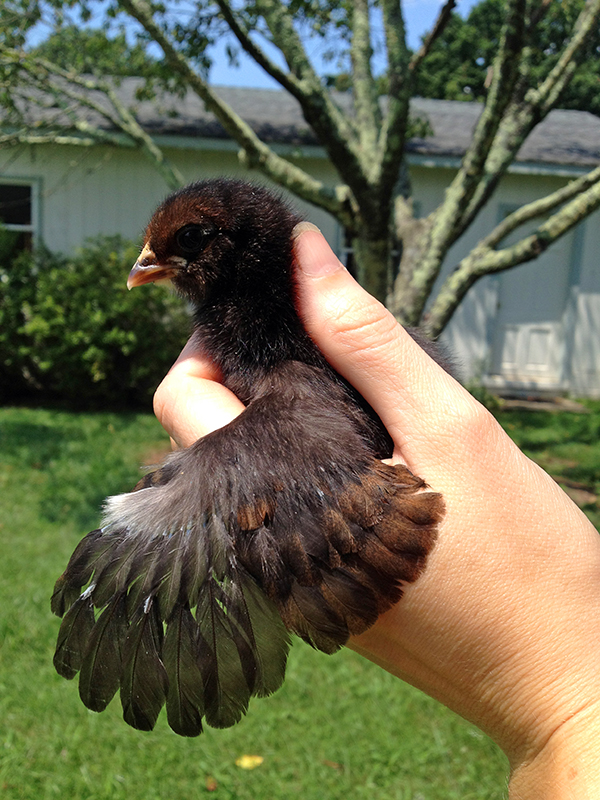
I am not sure if they will be any indication of the final coloration of the birds as adults, as coloration changes each time the chick molts. But it would be neat to have some brown hens—I don’t have any in the flock now.
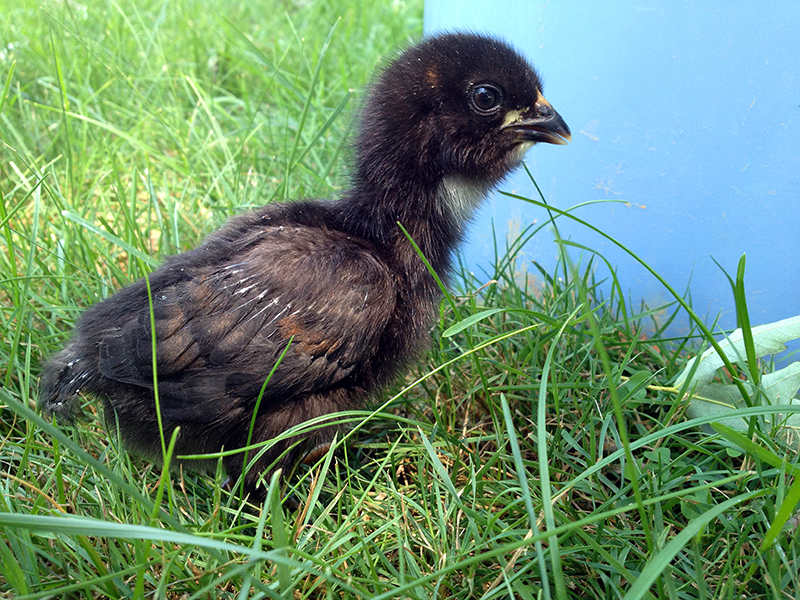
Some of the chicks still have their dried up umbilical cords attached. I never knew birds had umbilical cords until I saw them on the guineas that Iris hatched out last summer.
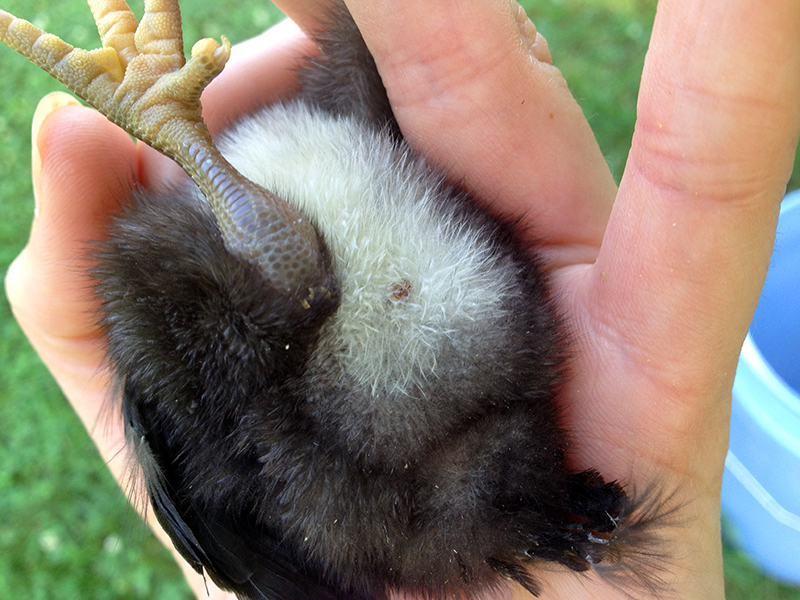
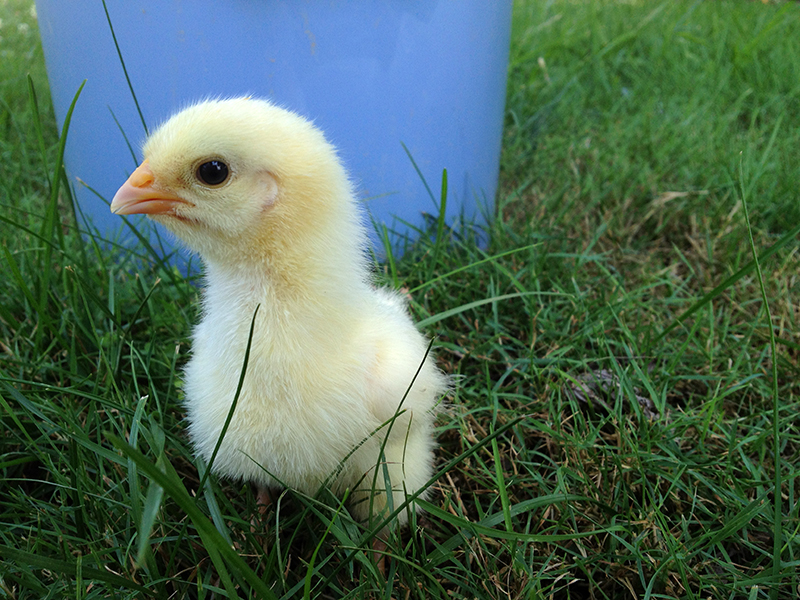
Here’s the sole Coronation Sussex chick. My $20 chicken (six hatching eggs cost $20, and this is the only bird I got out of them). Thankfully these birds are rare enough around here that if it’s a cockerel I should be able to sell him for at least $20.
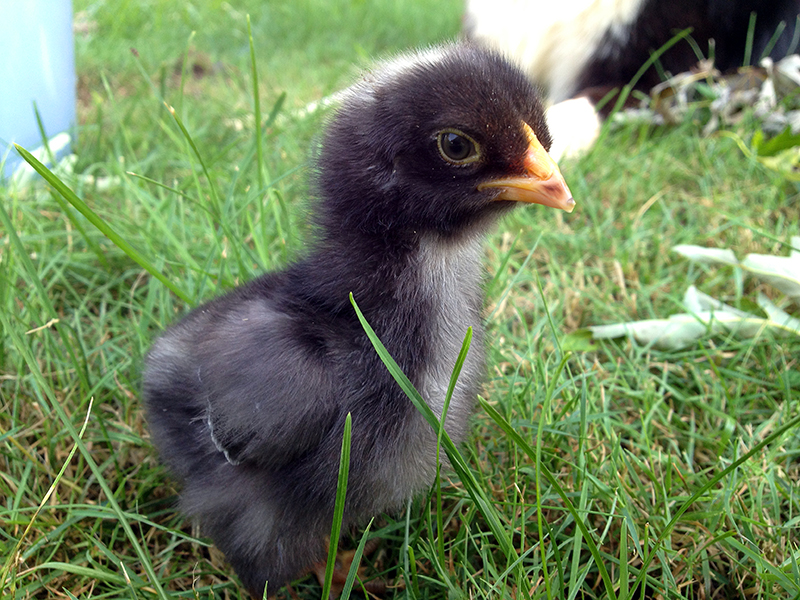
This is Griz, the only chick out of my barred olive egger Oregano and the chick whose egg survived car trips and refrigeration at my brother’s house. I let my brother name the chick. He picked Grizabella, but when the chick was born a boy the name got shortened to something more masculine. The white barring is just starting to show on his wing tips, and he’s got a bit of copper color to his head (which makes me think this coloration traveled in on my Wheaten Ameraucana rooster’s genes, as the black chicks have it too). But who knows!!? The neatest thing about making these breed crosses is seeing what they turn out to look like.
July 10th, 2013 §
There were no new babies born overnight, but around noon today I found a broken open Coronation Sussex egg. The embryo inside was well developed but still had a lot of yolk, so I know it wasn’t ready to be born. It was the egg that Dahlia chucked out of the nest on the first day of the hatch. Perhaps she did that because the embryo had died, or maybe it was out of the nest long enough to chill and stop developing. We’ll never know.
There was a Black Copper Marans egg in the process of hatching under Dahlia. It seemed to be struggling a bit, but I left it alone. When I came back hours later there was a new chick.
Once the chick had dried, I inspected it. Unfortunately it was born with a severe birth defect. It has only one eye, and its beak is misaligned.
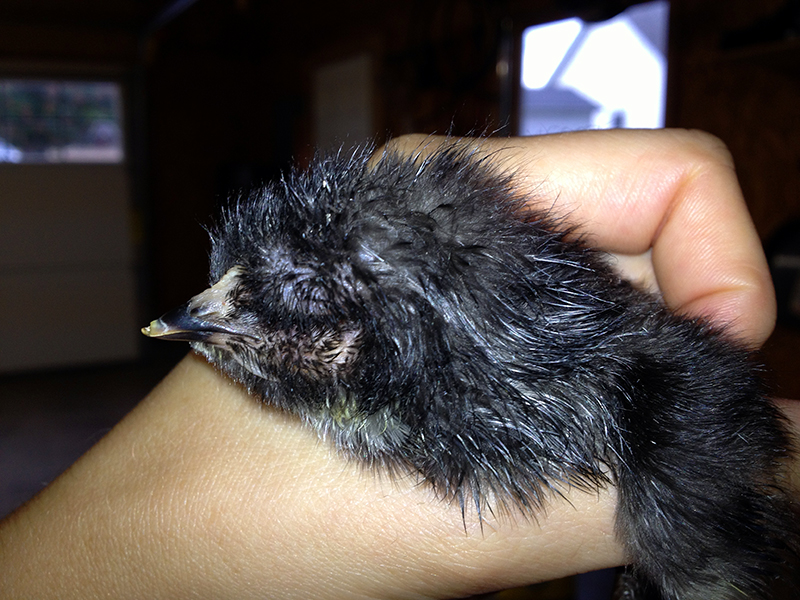
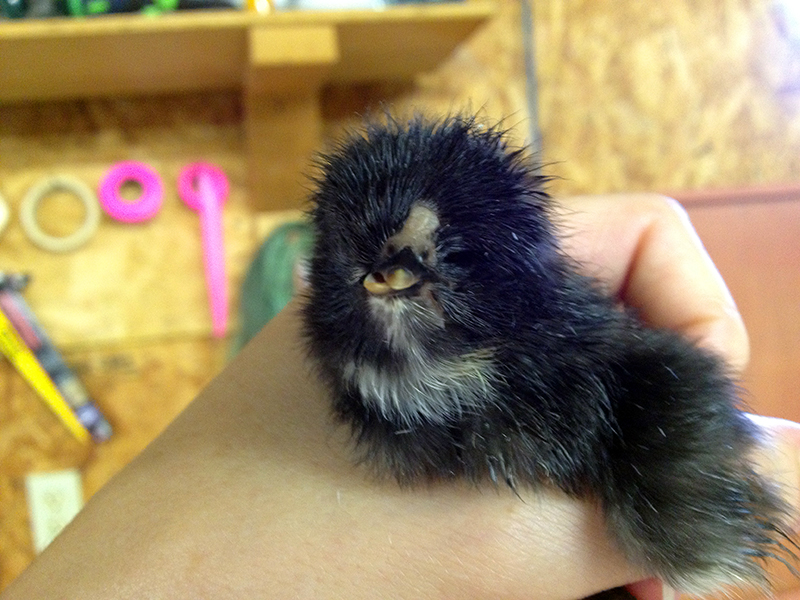
I suspect that there is no sight in its one eye, as it struggles to open that eye and doesn’t seem to respond to any visual stimuli.
I did some quick research and the prognosis isn’t good for a bird born with this defect. Some people can keep them alive with careful attention to making sure the bird gets enough to eat, but most people cull chicks born like this. That is what I plan to do.
The deformed chick, did, however, give me a good opportunity to get all six healthy chicks under Dahlia. I knew going into this that if I had just a few chicks, I would try to combine them under one hen. It didn’t make sense to double the work and cleanup of managing two coops of babies, and I knew that the older the birds got the more trouble I would have when it came time to combine both groups of babies. As I already know how potentially fraught introducing new birds to the main flock is, I wanted to minimize one extra step in the development of a new pecking order.
I chose to take the chicks away from Oregano because of the two birds, she seemed the less serious about mothering. She had pecked at the toes of the Coronation Sussex baby when it was brand-new, and today she was off the nest several times during the day, eating, drinking, and trying to dust bathe in the pine shavings. Not that one can blame her! Perhaps she knew the hatch was done and was trying to get her babies to follow her out to food and drink, but I didn’t get that sense from her.
I was stressed to put Oregano’s three chicks under Dahlia, but I did it one at a time and she didn’t bat an eye. The chicks dove right under her breast like they’d always been there, and there’s been no looking back. In fact, she led her babies off the nest this afternoon, leaving the deformed chick in the nest.
I took the unhatched eggs from Dahlia’s nest and added them to Oregano’s along with the deformed chick. I figured she’d go less crazy if she had a chick under her than if she had nothing and could hear chicks next door. But who knows, maybe she wouldn’t care? Anyway, the plan now is to give any remain eggs another day under Oregano to try to hatch, though I doubt any will, and then return Oregano to the main flock. Which might be tough if they see her as an intruder instead of a flock mate. Geez—managing these birds can really be a pain!
But if I get Oregano back with the flock, I should be in the clear. Dahlia can raise six chicks for as long as she likes, and I will deal with whatever comes next when it arrives. The good news is the six chicks now with Dahlia have spent the afternoon learning to eat and drink.
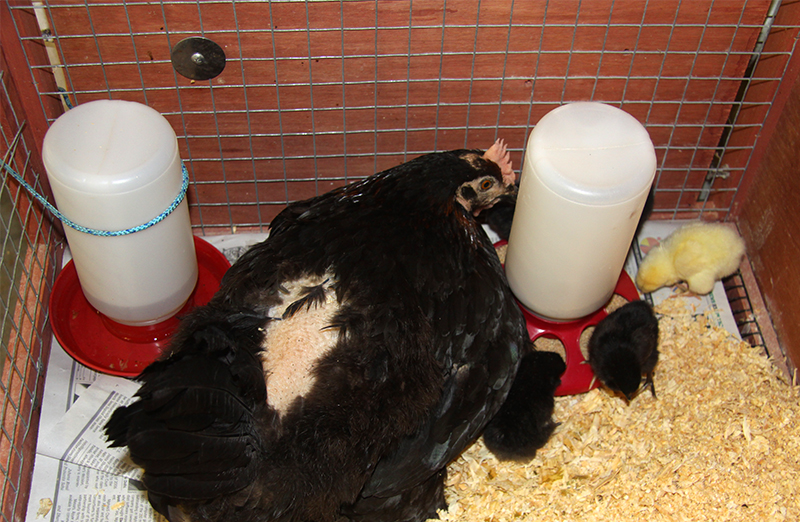
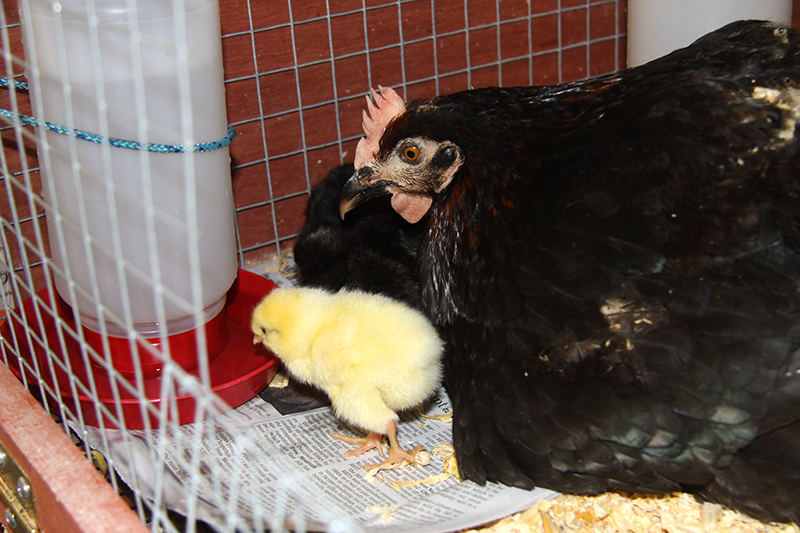
They are very active in the coop, pecking at everything including their mother’s comb (you can see a little blood spot in the photo above), wattles and even eyeballs, and seem healthy and happy. They run around, and when they are tired they dive into their mother’s feathers for a nap. Can you spot the stowaway?
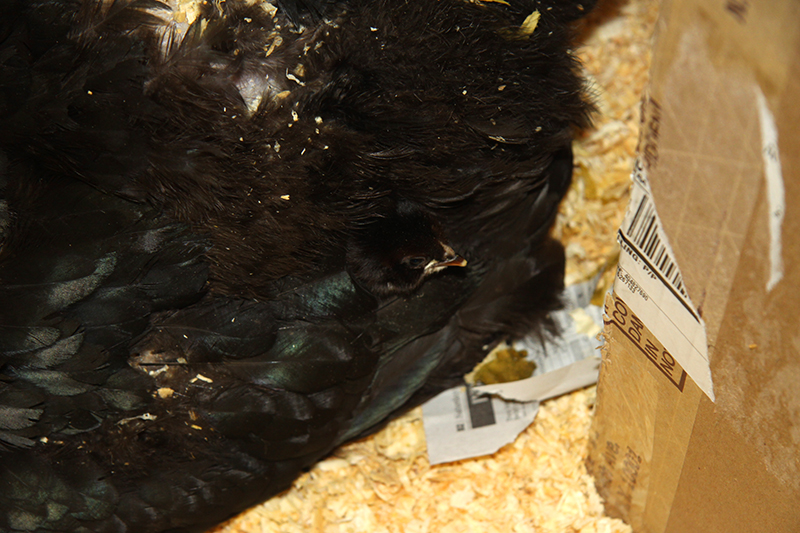
July 9th, 2013 §
There are new chicks, hatched early this evening, under both Dahlia and Oregano. Both are babies from Black Copper Marans eggs. Now each hen has three live babies, for a total of six on the ground. Oregano had one baby that pipped this evening, but it died before making it out of the shell. When I investigated, its yolk hadn’t yet been absorbed. I am starting to think the hot temperatures have affected this hatch, but that’s just a hunch and not substantiated yet with any research.

The chicks that were born last night are very active, hanging out at the front of the next box, pecking at shavings, and interacting with each other. Here are the yellow Coronation Sussex and the barred olive egger/wheaten Ameraucana boy.

They must be starting to think about food. Perhaps tomorrow they will take their first excursion out of the nest box. I am sure both mothers are also ready to get out of the nest. Notice how pale and dehydrated their combs and wattles are. Incubating eggs takes a lot out of a hen as they barely eat and drink just enough to keep from dying. They’ve both lost a bunch of weight—when I feel their chests all their breast muscle mass has shrunk away on either side of the keel bone.
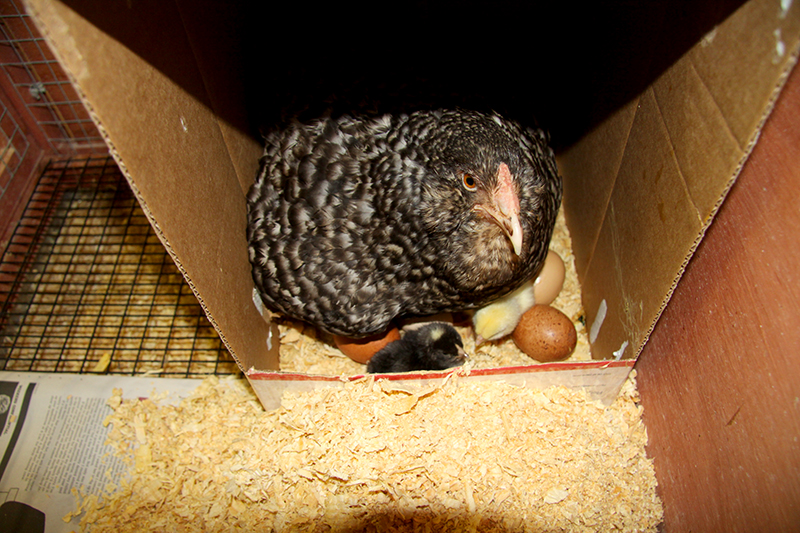
I find it interesting that when the guinea keets hatched last summer, they were way more active, way sooner than the chickens. The guinea keets were still wet from hatching and they’d already begun running out of the nest box. The chicks seem to be rather limp until they fluff up and find their legs. This little one under Dahlia has favored this front corner of the box all day. The chick has a few copper colored feathers, the same tone as mama’s, around its head and sides.
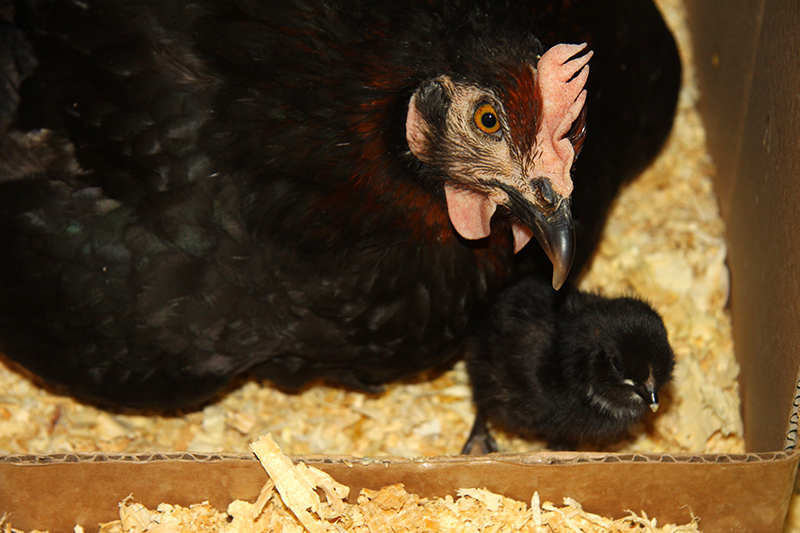
I suspect we might be done with this hatch. There aren’t any more pipped eggs, and nobody cheeped when I tapped on their shell. But we’ll see what the morning brings. I am ready to be done with this hatch phase, with its attendant death and stinky ooze, and on to seeing darling little fluff balls running all around the coop learning to be big chickens.
July 9th, 2013 §
At 8:00 a.m. I went out to check on the chicks. I heard peeping when I opened the garage door, so I knew there were babies somewhere!
Under Dahlia, two black chicks were just about all dried and fluffy. One came from a Black Copper Marans egg, which makes it an olive egger, and the other chick is Lilac’s baby. I saw one pipped egg but didn’t check them all.
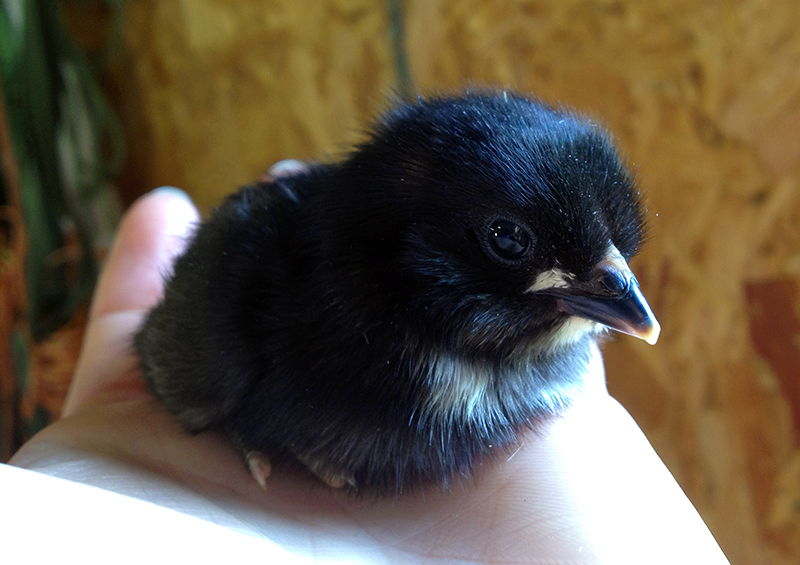
Under Oregano, the barred olive egger, there were two hatched chicks.
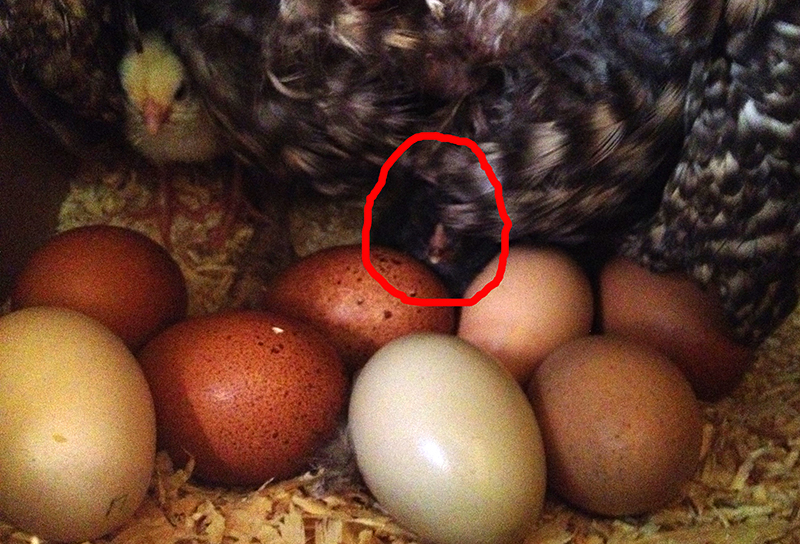
First up is a yellow Coronation Sussex baby!
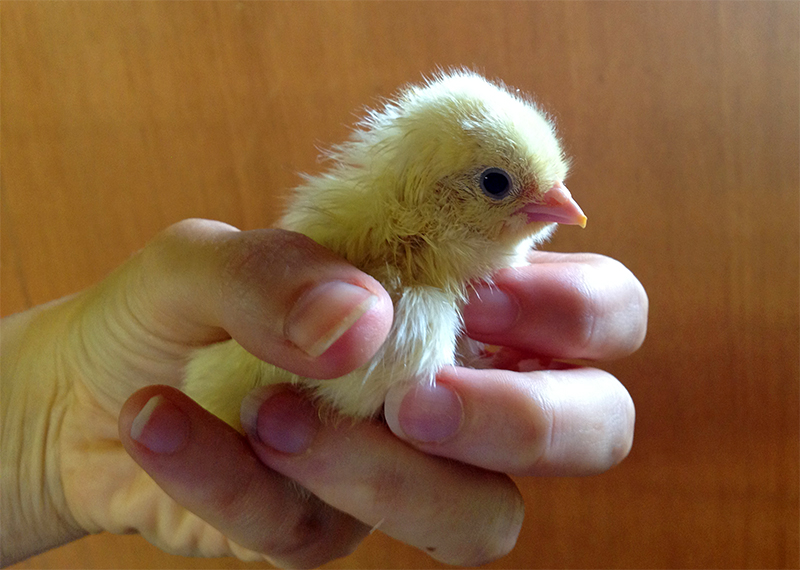
This is pretty exciting. And Oregano’s own egg, the one that journeyed to a Richmond refrigerator and back, had hatched during the night.
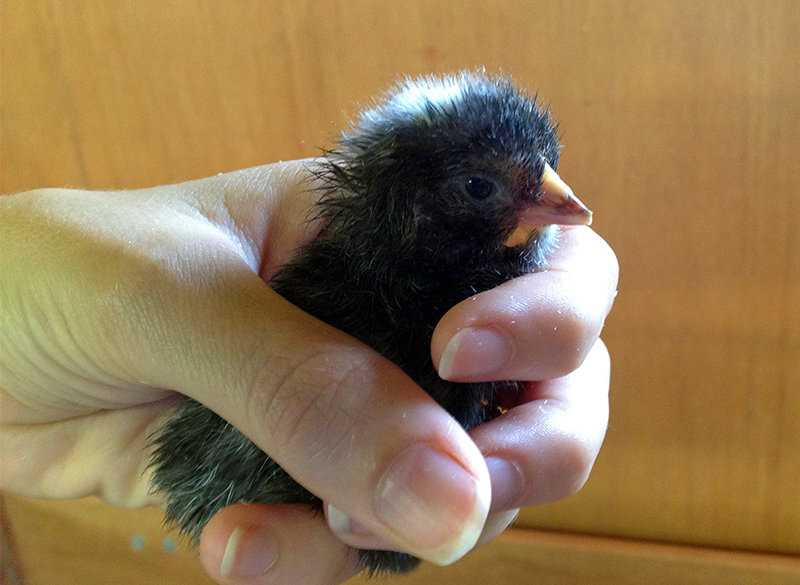
Unfortunately I think it’s a boy, as it has a white spot on its head, a sex-linked characteristic of barred breeds. Too bad I won’t get a chance at a super green egg layer this time around.
Meanwhile, here are the chicks’ empty eggshells. From top, the Coronation Sussex, then the barred olive egger, then Lilac’s egg, and finally a Black Copper Marans egg.
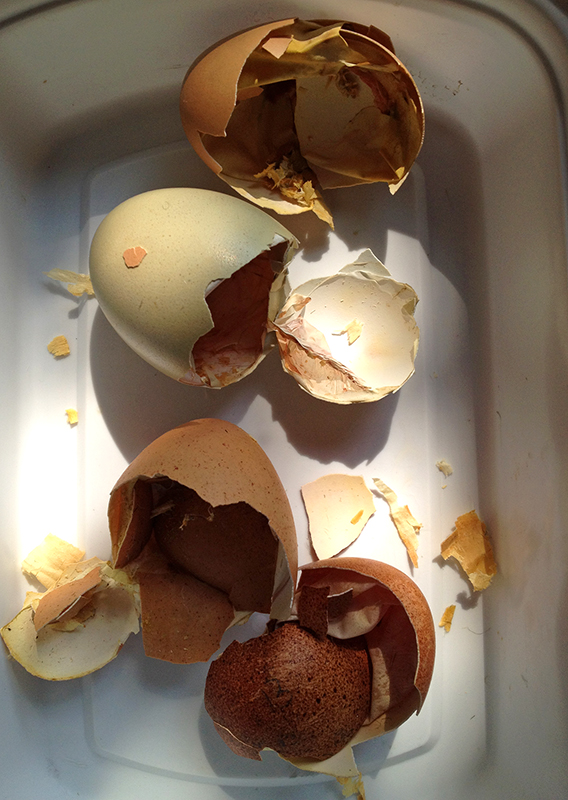
I saw another pipped egg in Oregano’s nest, so I left them in peace to continue hatching. There may be more babies to come, we’ll see.
July 8th, 2013 §
When I got Tuck in from his evening constitutional, around 10:30 p.m., I checked the nursery. There was a lot of action under Dahlia, lots of peeping and I saw a black chick partially emerged from its egg. Of course my phone battery was dead, so after it had charged up I headed back out, around 11:00 p.m., in hopes of getting a photo for you.

A chick! A real, live, healthy, vigorous chick! It obviously had a nice, quick, clean hatch, and was moving around like crazy. In the light of the flashlight, which I held in my mouth to take these photos, it bobbed and ducked and cheeped and burrowed deeper under Dahlia. She seemed to regard it with benign curiosity. Like, what is that? It’s a good thing she will have the whole dark night to get used to the idea of being a mother. Which she will be several times over, if the noises on her nest are any indication.
You can also see in the photo above the egg, on the right, that was pipped in my last post. Not too much development there.
Over in Oregano’s coop, it was much quieter. But, her egg, the olive egg, was definitely progressing. This is somewhat amazing as this is an egg that I put in a carton, carried in a warm car down to Richmond to give to my brother to eat, where it spent several days in a refridgerator before I realized Oregano had gone broody and ceased laying. This egg, and another that traveled with it, plus one I still had at home, were her only hope of biological offspring. So my brother carefully packaged the eggs for a return trip via my dad to Charlottesville, where I placed them back under their mother. One olive egg disappeared during incubation, and the other came up clear when I candled it. Thus I had zero expectation that through all this jostling, temperature change, etc., this egg would hatch, but here it is, tonight, with a peeping baby inside.

And here’s another egg, still pipping and making progress:

All eggs went immediately back under their mothers, and I came in to write this post before bed. I’d be lying if I said my heart didn’t stop seeing that healthy, wet baby under Dahlia. I am not the fainting type, but I felt lightheaded and swoony. I guess that’s what happens when you’re face to face with brand-new, much-hoped-for life. I could only imagine what it would feel like to see one’s human baby. If my reaction to new-born chickens is any indication, am not sure my heart would survive the crush of emotion.
I hope that the first check in the morning reveals nests full of fluffy, healthy, hungry chicks. That is my dream for tonight.
June 20th, 2013 §
Just want to report that both broody hens seem to have accepted their clutches. Despite dreaming Tuesday night that I awoke to find they had smashed all the eggs, everything was quiet when I opened the garage. Both hens are in the broody zombie state, and all looks good.
I forgot to mention a little ringer I threw into this project, just to keep it interesting. On Tuesday afternoon I met a lady at a gas station off Route 29 in Madison for a quick deal. She jumped out of a maroon minivan with a taped-over tail light as I pulled up behind the building. She handed me an egg carton containing six eggs, I forked over a $20, and lickety split, we separated and hit the road in different directions.
It was at its heart a true CraigsList deal. A few e-mails exchanged beforehand, a quick phone call, an arrangement to meet at a blessedly public place. My prize? Six Coronation Sussex hatching eggs.
Now, if you’re not familiar with the Coronation Sussex, allow me to introduce you:
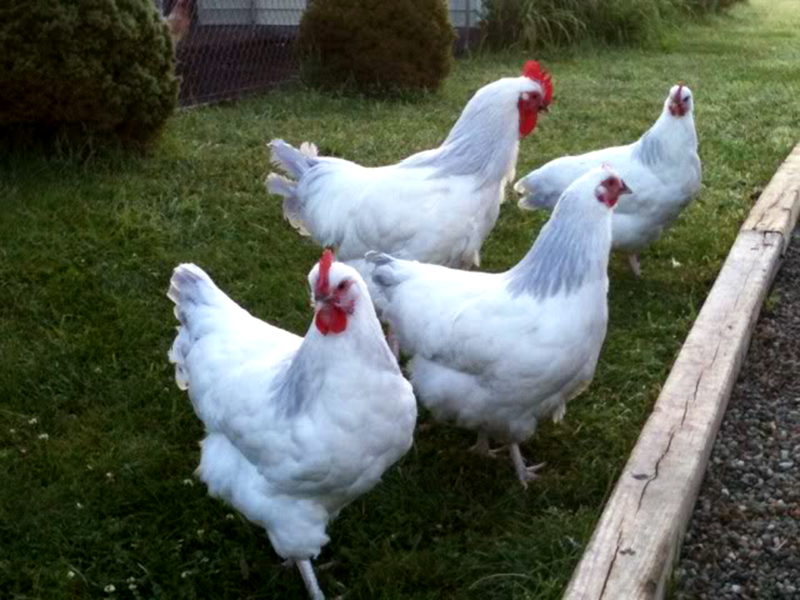
(Photo from BJs Poultry)
Pretty chickens, huh?
The eggs I bought supposedly come from Greenfire Farms lines, and you can read all about them and see more photos here. However, as with any CraigsList deal, you can never know. They could be store-bought eggs pulled from the fridge minutes before flying out the door. And, as with the purchase of any hatching eggs, one is never guaranteed a success. Don’t count your chickens…
Regardless of these known unknowns, I figured I’d give it a try. I’m not in the business of maintaining any fancy chicken bloodlines, so if I get a couple of pretty birds out of the deal that’s good enough for me!
Oh, and a very exciting possible farm development is underway. On Saturday I am visiting a farm over the mountain to talk to a lady about some baby goats. To, you know…just…visit…
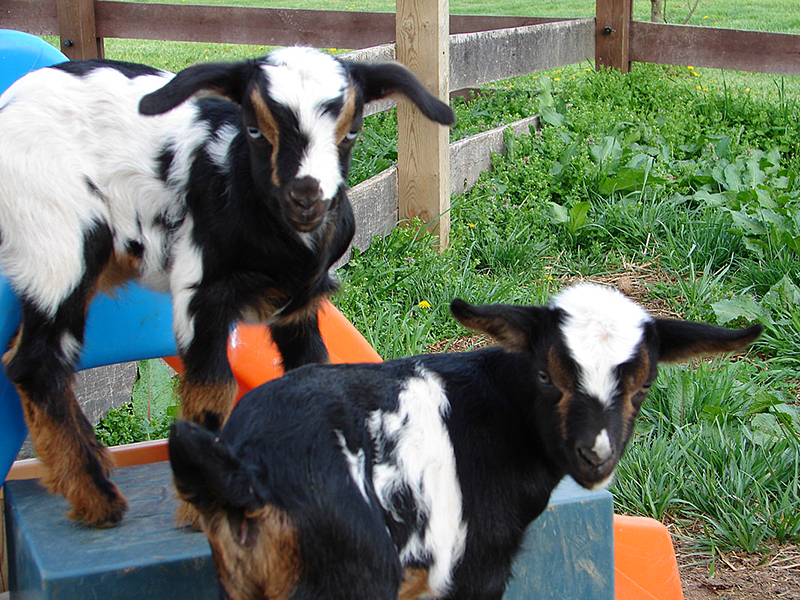
Stay tuned!
June 18th, 2013 §
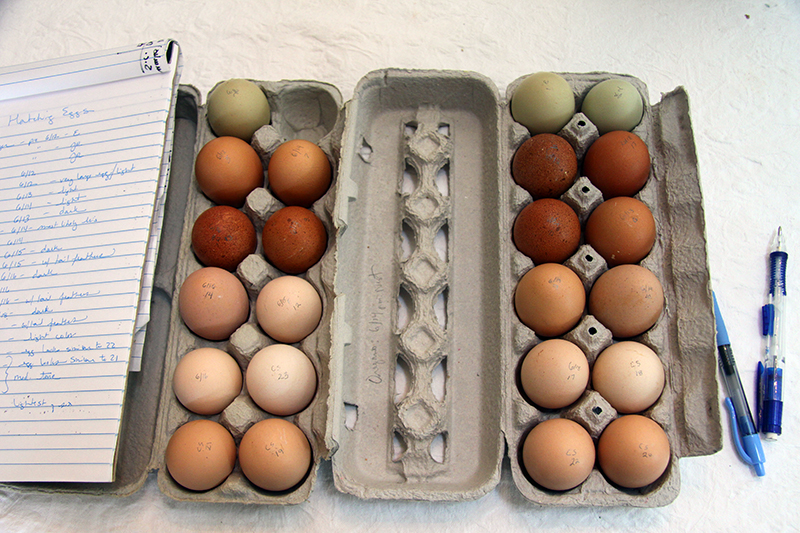
There are just a few intimate acts that are on par with reaching, in the dark, beneath a broody hen’s body, into the damp heat of her defeathered breast, feeling for eggs that pulse with embroynic blood. My years of developing film and photographs in the darkroom served me well as I navigated by feel alone. Oregano gave me a few good pecks on the wrist, bless her defensive spirit, and Dahlia let loose with a series of low perturbed squawks as I mussed about beneath her.
I took Oregano’s sacrifical eggs from her and and placed them in an old cardboard box grabbed off the garage floor, stretching as I did through the sticky web of a mother spider guarding her egg sac.
And then I replaced the stolen neverbabies with twelve fresh eggs for Oregano and eleven for Dahlia, of all colors and shapes, with a prayer for the suspended lives within.
And the 21-day countdown begins toward life or no life. It all comes down to the proper application of heat and humidity. Amazing, every time.




































